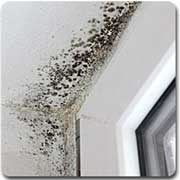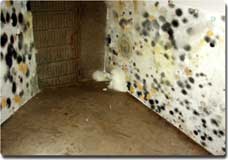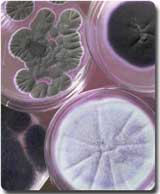Cleaning up Mold
 Dealing With Mold - Cleaning up mold can be a daunting task. Sometimes cleaning up mold should be done by a water or fire damage clean-up expert. In other cases it can be done by the homeowner. We will cover some of the basics of cleaning up mold. This is just a guideline and local, state, and national rules and regulations should be followed at all times.
Dealing With Mold - Cleaning up mold can be a daunting task. Sometimes cleaning up mold should be done by a water or fire damage clean-up expert. In other cases it can be done by the homeowner. We will cover some of the basics of cleaning up mold. This is just a guideline and local, state, and national rules and regulations should be followed at all times.
Mold Prevention - To help curb mold growth mold make sure that warm air flows into all parts of the structure. Move objects a few inches away from the inside of exterior walls to increase air circulation behind the objects particularly with larger objects. To prevent moisture build up you should install and use exhaust fans in bathrooms, kitchens, and laundry rooms. Also ventilate and insulate attics, crawl spaces and other areas where there may be stagnant air. Use heavy plastic to cover earth floors in unconditioned spaces. Make sure that closets and other areas without air circulation are not sealed too tight. If they are you can leave doors cracked, install a exhaust fan, or trim the bottoms of doors to allow air to enter. You should also vacuum and clean your home regularly and use a high quality filter in your central air conditioner or heater to help remove mold spores. Remember it is important to dry water-damaged areas and items within 24-48 hours to prevent mold growth. If possible, keep humidity in your house below 50% by using an air conditioner or dehumidifier. Avoid using carpeting in areas of the home that may become wet, such as kitchens, bathrooms and basements and dry floor mats regularly.
Testing for Mold - One of the easiest ways to find out if you have mold growing in your home is to use mold tests. Once you determine that you have a problem you should look for the sources of the mold. Inspect high probability areas like kitchens, bathrooms, basements, and attics for standing water, water stains and patches of out-of-place color. Don;t forget to check around the insides of your windows for signs of condensation. Search for moisture in areas that have a damp or moldy smell, like basements, kitchens and bathrooms. Look for visual signs of mold like water stains or evidence of mold such as colored, fuzzy growth on and around ceilings, walls, floors, windowsills and pipes. If you smell a musty odor coming from materials like carpeting, furniture or stored items separate them to be cleaned or discarded.
 Cleaning Up Mold - One of the first steps to cleaning up a mold problem is to dry out the house and fix any moisture problems. The first priority is to stop water leaks, repair leaky roofs and fix damaged plumbing. Make any changes needed to keep water away from concrete slabs and basement walls. Immediately clean and dry water damaged carpets, clothing, bedding, and upholstered furniture within 24 to 48 hours, or consider removing and replacing damaged furnishings. Remember that mold damages your home as it grows so clean it up as soon as possible.
Cleaning Up Mold - One of the first steps to cleaning up a mold problem is to dry out the house and fix any moisture problems. The first priority is to stop water leaks, repair leaky roofs and fix damaged plumbing. Make any changes needed to keep water away from concrete slabs and basement walls. Immediately clean and dry water damaged carpets, clothing, bedding, and upholstered furniture within 24 to 48 hours, or consider removing and replacing damaged furnishings. Remember that mold damages your home as it grows so clean it up as soon as possible.
Clean Yourself or Call a Professional? - First decide if you have a large or small area of mold to be cleaned. A small area that is less then about ten square feet is the most common size for self cleaning. This also will depend on the area to be cleaned. If the moldy area has been contaminated by sewage or is in hidden places, you should consider hiring a professional.
Protect Yourself - Wear goggles, gloves, and breathing protection while working in an area contaminated by mold. For large areas of mold growth, you should wear an Occupational Safety and Health Administration (OSHA) approved particle mask.
Seal Off the Area - The next step is to seal off the contaminated area from the rest of the structure. Cover heat registers or ventilation ducts and grills.
Ventilate the Area - Increase the ventilation in the area before you start to clean up. To increase air circulation in the area, open windows and doors. Use a fan to increase circulation in problem areas. Also remember that direct sunlight prevents mold growth.
 Remove Items - Remove all uncontaminated items to a mold-free area where they can be properly cleaned. Clean the surrounding moldy area then follow cleaning directions below for the items you removed. Bag all moldy materials that cannot be cleaned and tie off the top of the bag. Bring them outdoors and place them in your garbage container so the contamination will not be spread.
Remove Items - Remove all uncontaminated items to a mold-free area where they can be properly cleaned. Clean the surrounding moldy area then follow cleaning directions below for the items you removed. Bag all moldy materials that cannot be cleaned and tie off the top of the bag. Bring them outdoors and place them in your garbage container so the contamination will not be spread.
Cleaning Materials - The cleaning materials that you use will depend on the item or area to be cleaned.
Washable Surfaces that Don't Absorb Water - Scrub hard surfaces with a mild detergent solution, such as laundry detergent and warm water. Allow to dry. Then wipe the area with a solution of 1/4 cup bleach to one gallon of water. Wait 20 minutes and repeat until the area is completely clean. Last apply a borate-based detergent solution and don't rinse. This will help prevent mold from growing again. A borate-based laundry or dish washer detergent has "borate" listed on the ingredients label.
Washable Surfaces that Absorb Water - These include items like clothes, curtains, and bedding. First wash them in the laundry with hot water. Keep them separate and use small loads. Wash until all signs of mold are gone including the musty smell. If they do not come clean you may consider throwing them away.
Un-washable Surfaces that Absorb Water - Items like beds, sofas and other items may have to be discarded to prevent further contamination. If there is no odor you may try to save them by vacuuming well and allowing them to air out. Discard the item if you suspect mold is growing inside or outside the item.
Clean and Wash the Area - Once all contaminated items are removed give the entire area a good cleaning. You should vacuum and scrub floors, and wash any exposed areas.
 After the Clean-Up - Mold can come back, so watch for any mold growth or mold related health problems in any structure that has been cleaned of mold. Check regularly to make sure mold has not returned to the clean-up area or any other formerly uncontaminated areas in the contaminated structure. It is usually a good idea to check for mold using a home mold test 30 to 60 days after clean up is finished to make sure that mold has not returned even if there are no visible signs that the mold has returned. The cost of home mold testing is usually very small compared to the cost of an expensive repair.
After the Clean-Up - Mold can come back, so watch for any mold growth or mold related health problems in any structure that has been cleaned of mold. Check regularly to make sure mold has not returned to the clean-up area or any other formerly uncontaminated areas in the contaminated structure. It is usually a good idea to check for mold using a home mold test 30 to 60 days after clean up is finished to make sure that mold has not returned even if there are no visible signs that the mold has returned. The cost of home mold testing is usually very small compared to the cost of an expensive repair.
Click here to Order Parts from Ra-Jac Services Online Air-Conditioning and Heating Store
Take the guesswork out of shopping for high quality air conditioning and heating parts for your home or office. We offer only top quality parts that the professionals are using. Let our 40+ years in the air conditioning, heating, ventilation and refrigeration industry work for you.
Ra-Jac Air Conditioning & Heating has proudly served Galveston County TX since 1966. We pride ourselves on providing top notch service on residential and commercial air conditioning, heating, and refrigeration in the Southern Texas area.
We offer prompt and courteous service on air conditioning, heating, and refrigeration equipment.
Algoa / Arcadia / Bacliff / Bayou Vista / Clear Lake City / Clear Lake Shores / Dickinson / El Lago / Friendswood / Galveston / Hitchcock / Kemah / La Marque / League City / Nasa Area / Nassau Bay / San Leon / Santa Fe / Seabrook / Taylor Lake Village / Texas City / Tiki Island / Webster

